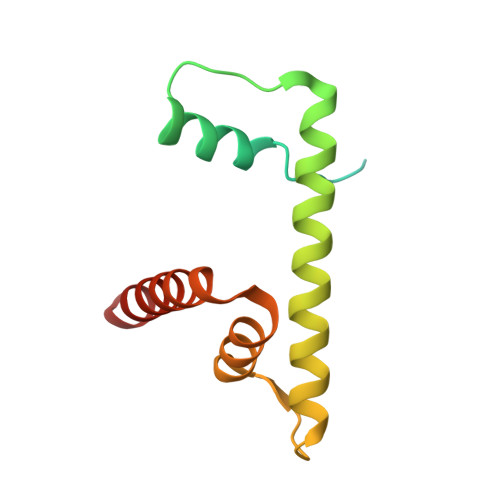BRCA1-BARD1 combines multiple chromatin recognition modules to bridge nascent nucleosomes.
Burdett, H., Foglizzo, M., Musgrove, L.J., Kumar, D., Clifford, G., Campbell, L.J., Heath, G.R., Zeqiraj, E., Wilson, M.D.(2023) Nucleic Acids Res 51: 11080-11103
- PubMed: 37823591
- DOI: https://doi.org/10.1093/nar/gkad793
- Primary Citation of Related Structures:
8OFF - PubMed Abstract:
Chromatin association of the BRCA1-BARD1 heterodimer is critical to promote homologous recombination repair of DNA double-strand breaks (DSBs) in S/G2. How the BRCA1-BARD1 complex interacts with chromatin that contains both damage induced histone H2A ubiquitin and inhibitory H4K20 methylation is not fully understood. We characterised BRCA1-BARD1 binding and enzymatic activity to an array of mono- and di-nucleosome substrates using biochemical, structural and single molecule imaging approaches. We found that the BRCA1-BARD1 complex preferentially interacts and modifies di-nucleosomes over mono-nucleosomes, allowing integration of H2A Lys-15 ubiquitylation signals with other chromatin modifications and features. Using high speed- atomic force microscopy (HS-AFM) to monitor how the BRCA1-BARD1 complex recognises chromatin in real time, we saw a highly dynamic complex that bridges two nucleosomes and associates with the DNA linker region. Bridging is aided by multivalent cross-nucleosome interactions that enhance BRCA1-BARD1 E3 ubiquitin ligase catalytic activity. Multivalent interactions across nucleosomes explain how BRCA1-BARD1 can recognise chromatin that retains partial di-methylation at H4 Lys-20 (H4K20me2), a parental histone mark that blocks BRCA1-BARD1 interaction with nucleosomes, to promote its enzymatic and DNA repair activities.
- Wellcome Centre for Cell Biology, University of Edinburgh, Michael Swann Building, Kings Buildings, Mayfield Road, Edinburgh EH9 3JR, UK.
Organizational Affiliation:






















